Herb gardening in raised beds offers a convenient and efficient way to cultivate a variety of herbs in a controlled environment. Whether you’re a novice or an experienced gardener, raised beds provide several benefits for growing herbs. From optimizing space to improving soil quality, the raised bed gardening method allows you to create a personalized herb garden that suits your needs and preferences.
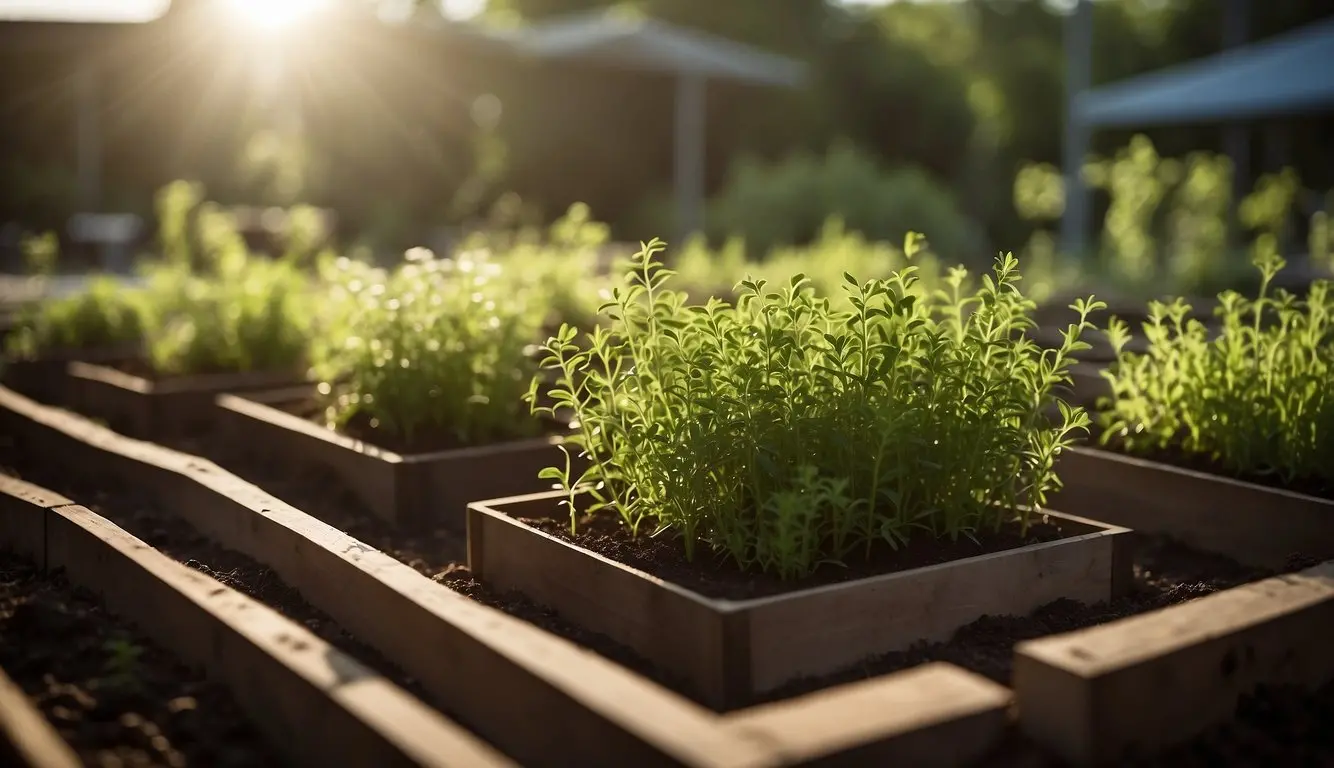
Planning your raised bed herb garden involves considering factors such as sunlight, drainage, and the types of herbs you want to grow. Proper soil and compost selection are crucial for the success of your herb garden, as they provide essential nutrients and support healthy plant growth. Additionally, understanding the watering and mulching techniques specific to raised bed gardening can help maintain optimal moisture levels and minimize weed growth in your herb garden.
Key Takeaways
- Raised beds offer a convenient and efficient way to cultivate a variety of herbs in a controlled environment.
- Proper planning, soil selection, and watering techniques are essential for successful raised bed herb gardening.
- Understanding the specific needs of popular herbs and implementing companion planting can enhance the biodiversity and overall health of your herb garden.
Table of Contents
Benefits of Raised Bed Herb Gardening
If you’re considering starting an herb garden, raised beds are a great option. Raised beds are essentially garden beds that are elevated above the ground. They offer several benefits over traditional in-ground gardening, especially for herb gardening.
Improved Drainage and Soil Quality
One of the key benefits of raised bed herb gardening is improved drainage and soil quality. With raised beds, you have more control over the type of soil you use. You can mix in compost, manure, and other organic matter to create a rich, fertile soil that drains well. This is especially important for herbs, which generally prefer well-draining soil.
Enhanced Growth and Accessibility
Raised beds also offer enhanced growth and accessibility. Because the soil is elevated, it warms up faster in the spring, allowing you to start planting earlier. Raised beds also provide better air circulation around your plants, which can help prevent diseases. Additionally, because the beds are elevated, you don’t have to bend over as much to tend to your plants, making it easier on your back.
Pest Control and Maintenance
Another advantage of raised bed herb gardening is better pest control and maintenance. With raised beds, you can easily install barriers to keep out pests like rabbits and groundhogs. You can also more easily control the soil quality and moisture levels, which can help prevent diseases and other issues. Additionally, raised beds require less maintenance than traditional in-ground gardening, as they don’t require tilling or weeding as often.
Overall, raised bed herb gardening offers several advantages over traditional in-ground gardening. With improved drainage and soil quality, enhanced growth and accessibility, and better pest control and maintenance, it’s a great option for anyone looking to start an herb garden.
Planning Your Raised Bed Herb Garden
When planning your raised bed herb garden, there are several factors to consider such as choosing the right location, determining the size and layout, and selecting materials for construction. By taking the time to plan your garden, you can ensure that your herbs will thrive and provide you with a bountiful harvest.
Choosing the Right Location
One of the most important factors to consider when planning your raised bed herb garden is choosing the right location. Herbs require at least six hours of sunlight each day, so it is important to choose a location that receives plenty of sun. Additionally, you should choose a location that is well-drained and has good soil. Avoid areas that are prone to flooding or have poor drainage.
Determining the Size and Layout
Before you begin constructing your raised bed, you should determine the size and layout of your garden. Consider how much space you have available and how many herbs you would like to grow. A good rule of thumb is to allow at least 12 inches of space between each plant. You can also consider using companion planting to maximize your space and create a more diverse garden.
Selecting Materials for Construction
When it comes to selecting materials for construction, there are several options to choose from. Wood is a popular choice for raised beds, but it is important to choose a type of wood that is resistant to rot and insect damage, such as cedar or redwood. Other options include metal, stone, or recycled materials. Whatever material you choose, make sure it is safe for growing herbs and does not contain any harmful chemicals.
Overall, planning your raised bed herb garden requires careful consideration of factors such as space, sunlight, materials, location, and layout. By taking the time to plan your garden, you can ensure that your herbs will thrive and provide you with a bountiful harvest.
Soil and Compost for Herb Gardens
When it comes to herb gardening in raised beds, soil and compost are two essential components that can make or break your herb growth. In this section, we’ll discuss how to create the perfect soil mix and the role of compost in herb growth.
Creating the Perfect Soil Mix
The soil mix you use for your raised bed herb garden should be light and airy to allow roots to breathe and grow freely while retaining enough moisture to keep the herbs hydrated. A good starting point is to mix equal parts of high-quality potting soil, compost, and coarse sand or perlite. You can adjust the ratio based on the specific needs of your herbs.
It’s important to note that not all soils are created equal. The quality of the soil you use can have a significant impact on your herb growth. Poor-quality soil can lead to stunted growth, nutrient deficiencies, and pest problems. So, it’s essential to invest in high-quality soil to ensure the health and vitality of your herbs.
The Role of Compost in Herb Growth
Compost is a valuable source of nutrients for your herb garden. It’s rich in essential minerals and organic matter that can help improve soil structure, aeration, and water-holding capacity. Compost can also help regulate soil pH, which is critical for the health and growth of your herbs.
When adding compost to your soil mix, aim for a ratio of 1:1, or equal parts compost and soil. You can also use compost as a top dressing around your herbs to provide a slow-release source of nutrients throughout the growing season.
In conclusion, creating the perfect soil mix and using compost are crucial for the success of your raised bed herb garden. By investing in high-quality soil and compost, you’ll be providing your herbs with the essential nutrients and growing conditions they need to thrive.
Planting Herbs in Raised Beds
When planting herbs in raised beds, it is essential to consider the selection of herbs and their spacing to ensure optimal growth and yield. Additionally, understanding the process of transplanting seedlings and direct sowing is crucial for successful herb gardening.
Herb Selection and Spacing
Selecting the right herbs for your raised bed is key to a thriving garden. Consider the growth habits and space requirements of each herb. For instance, herbs like basil, rosemary, and sage may need more space, while thyme, oregano, and lavender can be planted closer together.
Creating a planting plan can help you visualize the layout and ensure adequate spacing between herbs. Utilize a planting chart or table to organize your herb selection and spacing requirements efficiently.
Transplanting Seedlings and Direct Sowing
Transplanting seedlings into your raised bed allows for a head start in the growing process. Ensure the seedlings are well-established and acclimated to outdoor conditions before transplanting. When direct sowing seeds, follow the recommended planting depth and spacing for each herb variety.
Properly preparing the soil in your raised bed before planting is essential for successful transplanting and direct sowing. Ensure the soil is well-draining and rich in nutrients to support healthy herb growth.
By carefully considering herb selection, spacing, and the transplanting process, you can create a flourishing herb garden in your raised beds.
Watering and Mulching Techniques

Irrigation Strategies for Raised Beds
One of the most important aspects of herb gardening in raised beds is ensuring that your plants receive adequate water. Because raised beds are typically elevated off the ground, they tend to dry out more quickly than traditional garden beds. Therefore, it’s essential to have a consistent watering schedule.
One effective irrigation method for raised beds is drip irrigation. This system delivers water directly to the roots of your plants, minimizing water waste and reducing the likelihood of fungal diseases. You can purchase drip irrigation kits at most garden centers or online retailers.
Another option is to use a soaker hose. This type of hose is designed to release water slowly and evenly, allowing it to seep into the soil and reach the roots of your plants. Soaker hoses are an affordable and easy-to-use option for raised bed irrigation.
Benefits of Mulching for Herb Gardens
Mulching is an essential practice for any herb garden, but it’s especially important for raised beds. Mulch helps to retain moisture in the soil, reducing the frequency of watering required. Additionally, it helps to suppress weed growth and regulate soil temperature.
There are several types of mulch that work well in herb gardens. Organic mulches, such as straw, leaves, and grass clippings, break down over time and add nutrients to the soil. Inorganic mulches, such as gravel or landscape fabric, do not break down but provide long-lasting weed suppression.
When applying mulch to your raised bed, be sure to spread it evenly and avoid piling it up around the stems of your plants. This can lead to moisture buildup and increase the risk of fungal diseases. A layer of 2-3 inches of mulch is typically sufficient for most herb gardens.
By following these watering and mulching techniques, you can ensure that your raised bed herb garden thrives and produces a bountiful harvest.
Growing Popular Herbs
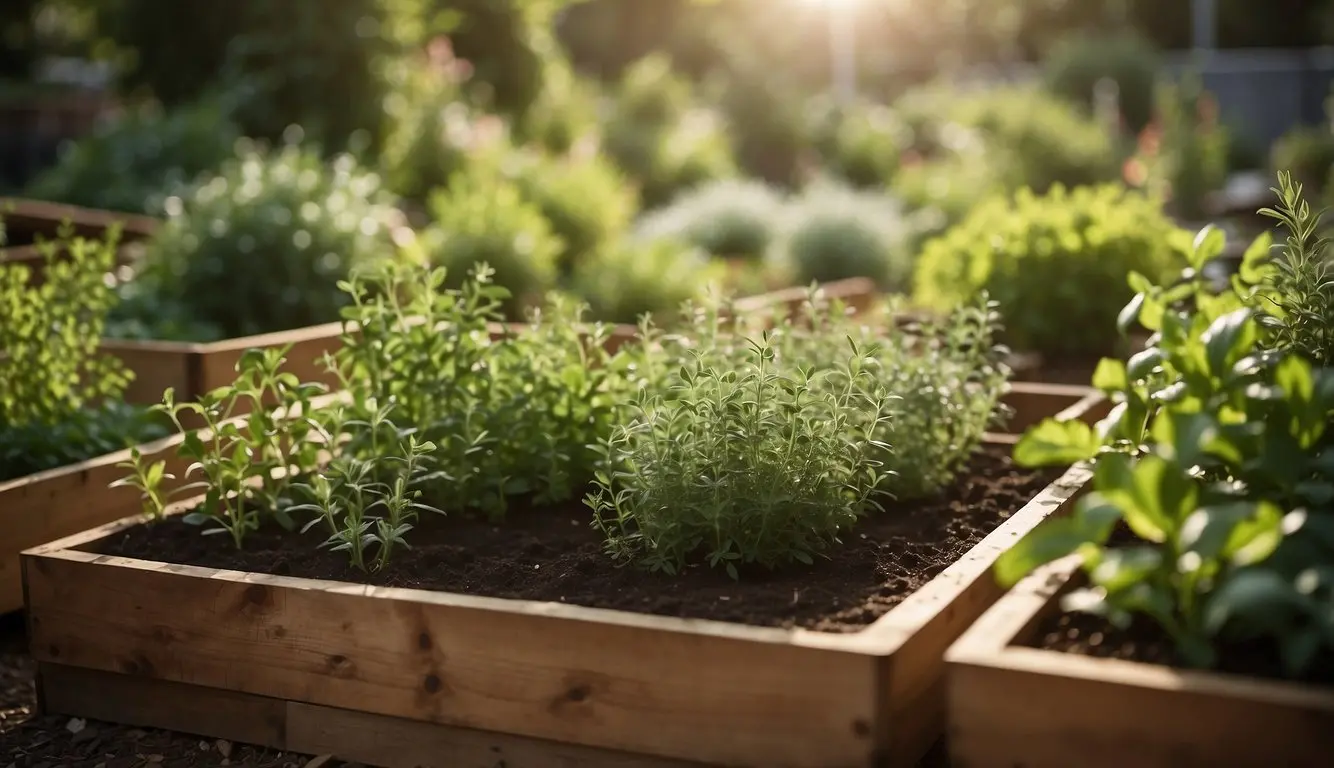
When it comes to herb gardening in raised beds, there are plenty of options to choose from. Here are some of the most popular herbs that you can grow in your raised bed.
Cultivating Mediterranean Herbs
Mediterranean herbs are a great choice for raised bed gardening because they love the warm, dry weather. These herbs include rosemary, oregano, thyme, and sage. They are all perennial herbs, which means they will come back year after year.
Rosemary is a woody herb that grows best in well-drained soil and full sun. It is perfect for flavoring grilled meats and roasted vegetables. Oregano is another Mediterranean herb that is easy to grow in a raised bed. It is a great addition to Italian dishes like pizza and pasta sauces. Thyme is a low-growing herb that is perfect for ground cover in your raised bed. It is a great addition to soups and stews. Sage is a versatile herb that can be used in stuffing, sauces, and marinades.
Annual and Perennial Herb Varieties
In addition to Mediterranean herbs, there are plenty of annual and perennial herbs that you can grow in your raised bed. Basil is an annual herb that loves warm weather and plenty of sun. It is a great addition to pesto, salads, and sandwiches. Cilantro is another annual herb that is easy to grow in a raised bed. It is perfect for adding flavor to salsa and guacamole.
Dill is an annual herb that is easy to grow from seed in your raised bed. It is perfect for flavoring fish and pickles. Chives are a perennial herb that is easy to grow and adds a mild onion flavor to dishes. Lavender is a perennial herb that is perfect for adding fragrance to your garden. It is also a great addition to baked goods and teas. Parsley is a biennial herb that is perfect for garnishing dishes and adding flavor to soups and stews.
In conclusion, growing herbs in raised beds is a great way to add flavor and fragrance to your garden. With so many options to choose from, you are sure to find the perfect herbs to grow in your raised bed.
Maintaining Your Herb Garden

Once you have planted your herbs in raised beds, it is important to maintain them properly to ensure a healthy and productive garden. Here are some tips on maintaining your herb garden:
Pruning and Harvesting Herbs
Pruning and harvesting your herbs regularly is essential for maintaining their health and promoting growth. Pruning involves removing any dead or damaged leaves or stems, which can help prevent disease and pests from spreading. Harvesting involves cutting off the leaves or stems of your herbs when they are ready to be used.
To prune your herbs, use a pair of sharp, clean scissors or pruning shears. Cut off any dead or damaged leaves or stems, making sure to cut just above a leaf node. This will encourage new growth and help keep your herbs looking healthy.
When harvesting your herbs, make sure to only take what you need, and avoid harvesting more than one-third of the plant at a time. This will allow the plant to continue growing and producing new leaves or stems.
Managing Weeds and Overcrowding
Weeds can quickly take over your herb garden if left unchecked, so it is important to manage them regularly. Pull out any weeds by hand, making sure to get the roots to prevent them from regrowing. You can also use a hoe or cultivator to loosen the soil around the weeds, making it easier to pull them out.
Overcrowding can also be a problem in raised bed herb gardens. If your herbs are too close together, they can compete for nutrients and water, which can stunt their growth. To prevent overcrowding, make sure to space your herbs out properly when planting them. If you notice overcrowding later on, you may need to thin out some of your plants to give the others more room to grow.
In summary, maintaining your herb garden is essential for promoting growth and preventing disease and pests. Regular pruning and harvesting, as well as managing weeds and overcrowding, will help keep your raised bed herb garden healthy and productive.
Companion Planting and Biodiversity
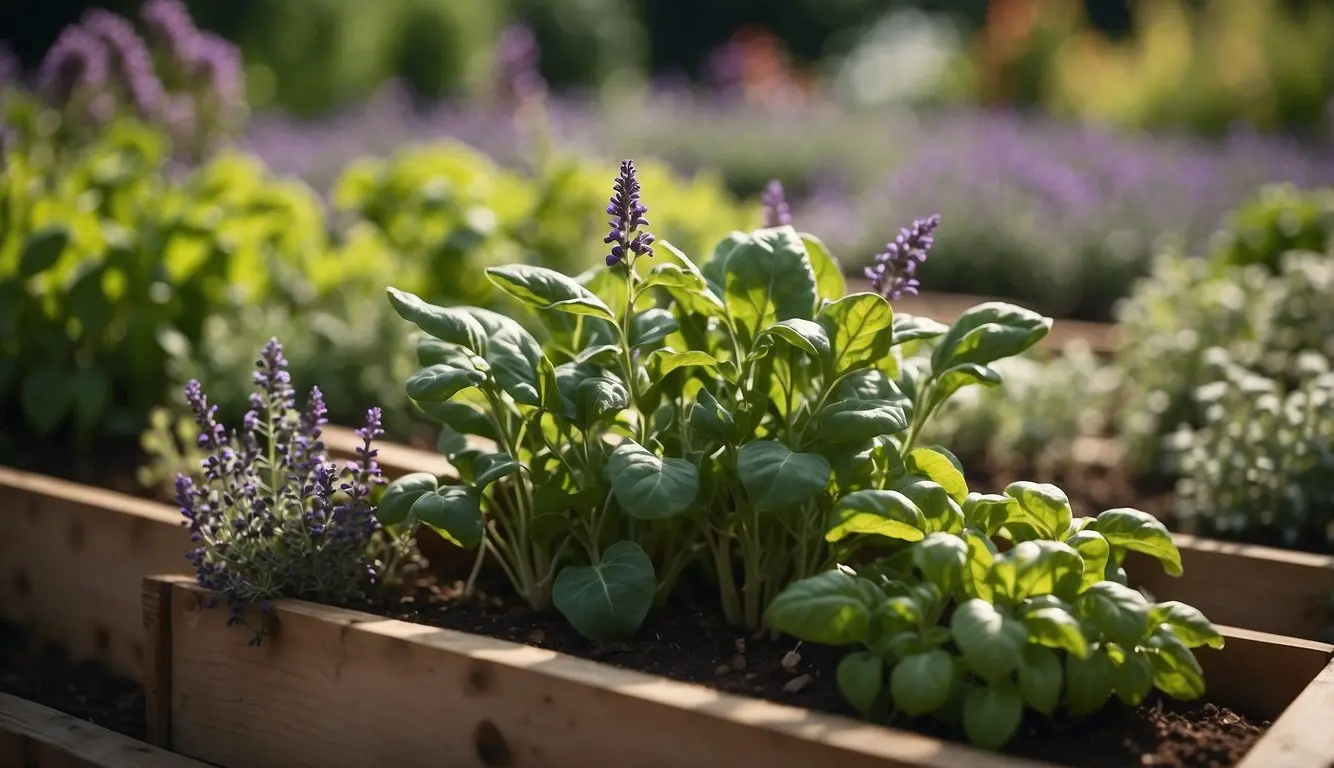
When it comes to herb gardening in raised beds, companion planting is an effective way to promote biodiversity and enhance the health of your plants. Companion planting involves growing different plants together that have a mutually beneficial relationship. By planting certain plants together, you can help to repel pests, attract beneficial insects, and improve soil health.
Beneficial Companion Plants
Some herbs make great companion plants for other herbs and vegetables. For example, planting basil with tomatoes can help to repel pests and improve the flavor of the tomatoes. Similarly, planting marigolds with other herbs and vegetables can help to repel pests and attract beneficial insects like ladybugs and lacewings.
Attracting Pollinators and Beneficial Insects
Pollinators like bees and butterflies are essential for the health of your garden. By planting flowers like lavender, chamomile, and echinacea, you can attract these important insects and help to ensure that your plants are pollinated. In addition to pollinators, there are many beneficial insects that can help to control pests in your garden. By planting herbs like dill, fennel, and parsley, you can attract these insects and keep your garden healthy.
Overall, companion planting is an effective way to promote biodiversity and enhance the health of your herb garden in raised beds. By planting a variety of herbs and vegetables together, you can create a thriving ecosystem that benefits all of your plants.
Dealing with Common Pests and Diseases
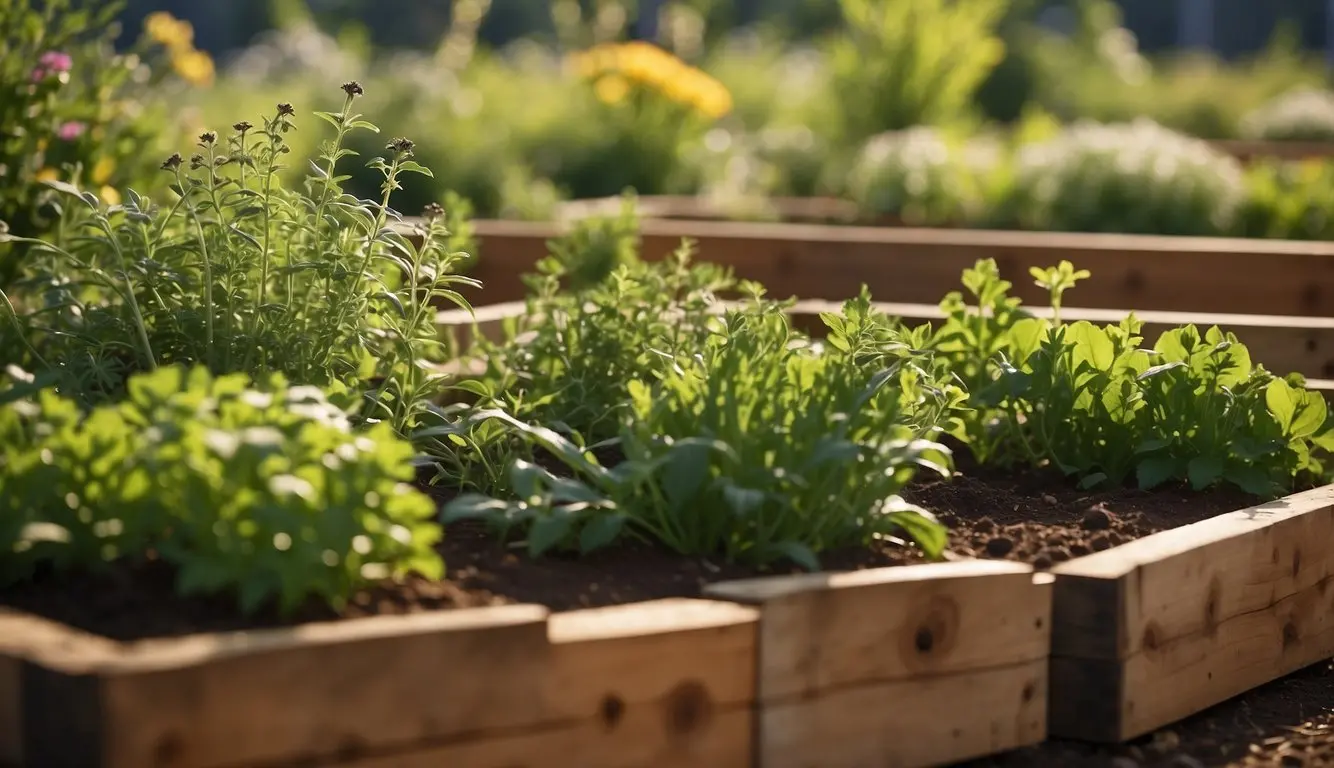
Herb gardening in raised beds is an excellent way to grow your own fresh herbs, but it’s not without its challenges. Pests and diseases can quickly take over and damage your plants, but with a few preventative measures and organic pest control methods, you can keep your plants healthy and thriving.
Organic Pest Control Methods
One of the most common pests in herb gardens is aphids. These tiny insects can quickly infest your plants and cause damage. To control aphids, you can use a homemade insecticidal soap made from dish soap and water. Mix one tablespoon of dish soap with one quart of water and spray the mixture on your plants. The soap will suffocate the aphids and prevent them from reproducing.
Another common pest in herb gardens is slugs. These slimy creatures can quickly devour your plants, leaving them in shambles. To control slugs, you can use a natural slug bait made from beer. Place a shallow dish of beer in your garden, and the slugs will be attracted to it. They will crawl into the dish and drown.
Spider mites are another common pest in herb gardens. These tiny insects can quickly infest your plants and cause damage. To control spider mites, you can use a homemade garlic spray. Crush several cloves of garlic and mix them with water. Let the mixture sit for a few days, then strain it and spray it on your plants. The garlic will repel the spider mites and prevent them from reproducing.
Preventing Diseases in Herbs
Diseases can also be a problem in herb gardens. To prevent diseases, it’s important to keep your plants healthy and well-maintained. Make sure your plants are getting enough water and sunlight, and prune them regularly to remove any dead or diseased leaves.
One common disease in herb gardens is powdery mildew. This fungal disease can quickly spread and damage your plants. To prevent powdery mildew, make sure your plants are not overcrowded and have good air circulation. You can also use a homemade fungicide made from baking soda and water. Mix one tablespoon of baking soda with one quart of water and spray the mixture on your plants.
By using these organic pest control methods and preventative measures, you can keep your herb garden healthy and thriving. Remember to check your plants regularly for pests and diseases, and take action as soon as you notice a problem. With a little effort, you can enjoy a bountiful harvest of fresh herbs all season long.
Harvesting and Using Your Herbs

Once your herbs have grown and matured, it’s time to start harvesting them. Here are some best practices for harvesting and using your herbs in raised beds.
Best Practices for Harvesting
When it comes to harvesting herbs, timing is everything. You should harvest your herbs in the morning when the oils are at their peak. Use a sharp pair of scissors or pruning shears to cut the herbs at the base of the stem. Avoid pulling or tearing the herbs, as this can damage the plant and reduce its future growth.
When harvesting your herbs, be sure to leave at least one-third of the plant intact. This will allow the plant to continue growing and producing new leaves. You should also avoid harvesting more than you need at one time, as this can cause the plant to become stressed and reduce its overall flavor.
Storing and Preserving Fresh Herbs
Fresh herbs are best used immediately, but if you have more than you can use at once, there are several ways you can store and preserve them. One of the easiest ways is to simply place the herbs in a jar of water and store them in the refrigerator. This will keep the herbs fresh for several days.
Another option is to dry your herbs. To do this, tie the herbs together in small bundles and hang them upside down in a warm, dry place. Once the herbs are completely dry, remove the leaves from the stems and store them in an airtight container.
You can also freeze your herbs for later use. To do this, chop the herbs into small pieces and place them in ice cube trays. Fill the trays with water and freeze. Once the cubes are frozen, remove them from the trays and store them in a freezer bag. This will keep your herbs fresh for several months.
By following these best practices for harvesting and storing your herbs, you can ensure that you always have fresh flavor on hand in your kitchen.
Frequently Asked Questions
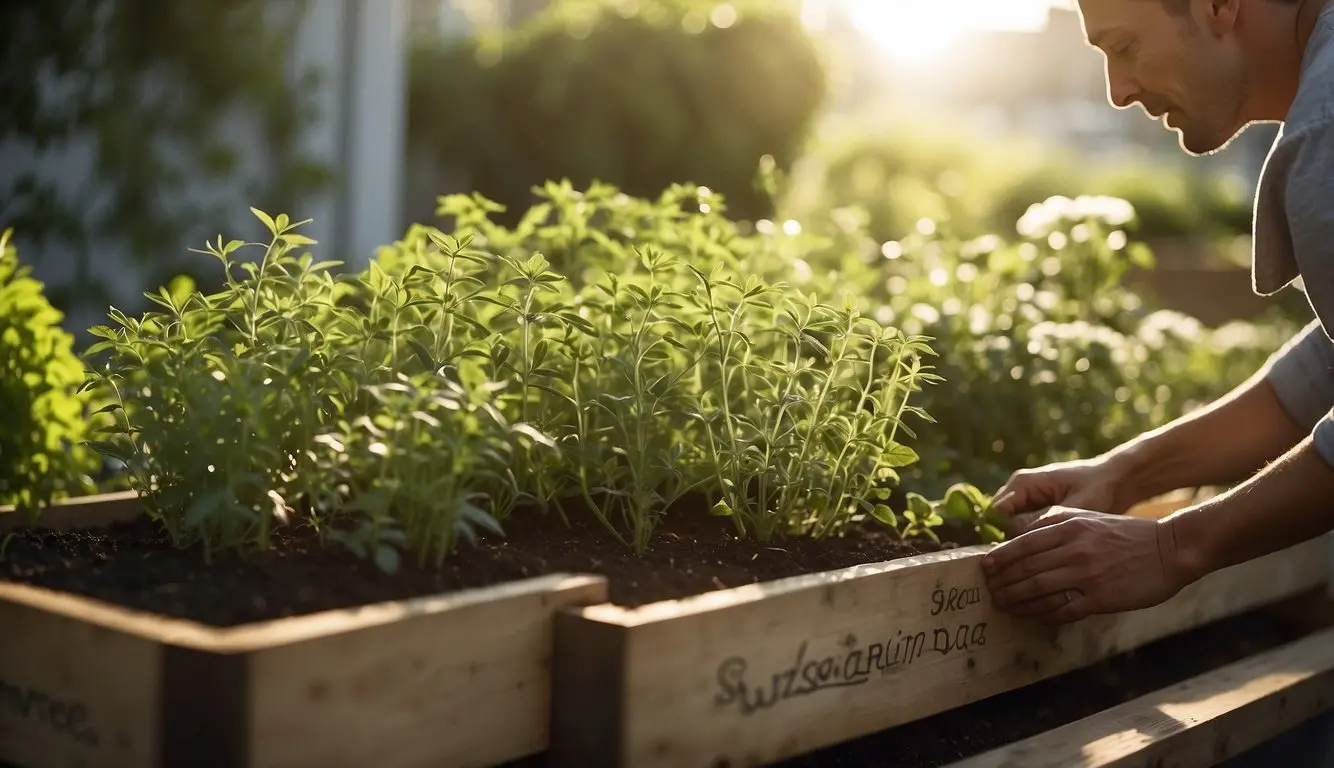
What are the ideal dimensions for a raised bed when planting herbs?
When planting herbs in a raised bed, the ideal dimensions typically range from 6 to 12 inches deep, depending on the variety of herbs you intend to grow. The raised bed should provide enough room for the roots to establish and thrive.
How should herbs be arranged within a raised garden bed for optimal growth?
For optimal growth, it’s recommended to place taller herbs such as rosemary and sage toward the back of the raised bed, as they can grow larger and provide a natural backdrop for the rest of the garden. Medium-sized herbs like thyme, oregano, and lavender should be planted in the middle rows to add depth and fill out the garden.
Can you recommend some companion plants for herbs in a raised bed garden?
Companion plants such as marigolds, dill, and chamomile can be beneficial for herb gardens. Marigolds can help deter pests, while dill and chamomile can attract beneficial insects.
What is the best soil mixture for cultivating herbs in raised beds?
A well-draining soil mixture with a balanced blend of compost, peat moss, and perlite or vermiculite is ideal for cultivating herbs in raised beds. This mixture provides the necessary nutrients and drainage for healthy herb growth.
Which herbs are best suited for growing in elevated garden planters?
Herbs such as basil, thyme, parsley, chives, and mint are well-suited for growing in elevated garden planters. These herbs thrive in containers and are relatively low-maintenance.
What are some effective DIY raised herb garden designs?
Effective DIY raised herb garden designs include using materials like cedar or redwood to construct durable and aesthetically pleasing raised beds. Additionally, modular metal garden beds can offer fast set-up and high-quality options for creating your home herb garden.
- Best Brush Cutter: Top 5 Models for Lawn Maintenance in 2024 - January 10, 2024
- Protecting Your Garden from Rodent Damage: Tips and Tricks - December 14, 2023
- Small Space Gardening: Transform Your Garden with Raised Beds - December 10, 2023
